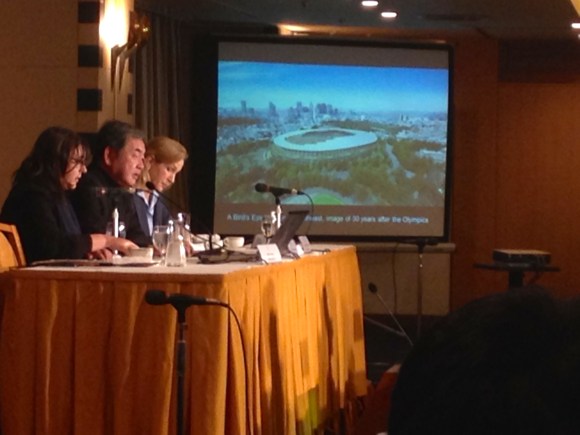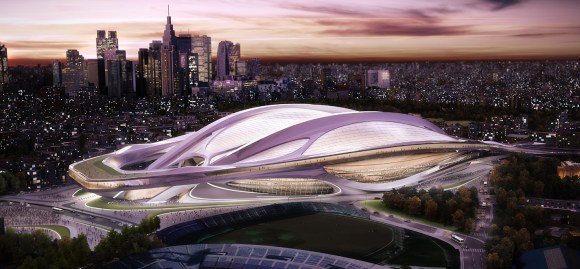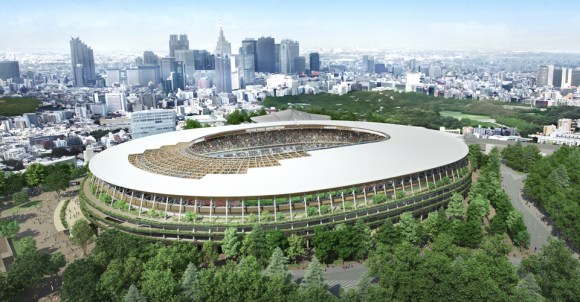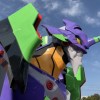
It seems controversy over the new National Stadium for the Tokyo 2020 Olympics isn’t over yet.
Let’s have a quick recap of the National Stadium saga for those of you playing along at home.
In the bid to get the Olympics, organizers decided to tear down the beloved 54,000-seat National Stadium in Shinjuku Ward, the centerpiece the 1964 Tokyo Olympics, and build a new stadium on the same site. In 2012, a design from award-winning Iraqi-British architect Zaha Hadid and her London-based firm was chosen.
▼ The original design by Zaha Hadid Architects

Tokyo was awarded the Games in September of 2013, but just three months later, Hadid was asked to revise her design due to ballooning costs. Even after the revisions, the total cost stood at 250 billion yen, more than three times the cost for the London 2012 main stadium and double the amount Tokyo organizers were hoping to achieve.
Organizers and Hadid disagreed on the cause of the budget problem, with Hadid placing the blame largely on rising material and manpower costs and the Olympic committee pointing the finger at difficult-to-build elements in the design. Hadid also suggested that resentment over a non-Japanese architect being chosen played a role in the conflict. Finally, her design was scrapped and another design competition was held.
The new winner was a design submitted by Japanese architect Kengo Kuma in cooperation with construction firm Taisei Corp. and design firm Azusa Sekkei Co., both of which were contractors working on the Hadid design.
▼Kengo Kuma’s design

Hadid and others pointed to similarities between the designs, the overlapping contractors and the fact that the new design was drawn up in just 14 weeks, compared to two years for Hadid’s original, to suggest that parts of the new stadium had been plagiarized from her work. These accusations were bolstered when the Telegraph reported that Japan Sport Council was withholding payment until Hadid signed a new contract releasing the copyright to her designs and submitting to a gag order on the matter. Hadid has refused to sign the new contract and threatened legal action.
Last Friday, Kuma held a press conference in Tokyo to talk about his design and he firmly denied that any of it was plagiarized.
Kuma admitted that there were some similarities between the two designs, but chalked this up to the requirements of the project. For example, both stadiums use a three-layer structure, but Kuma said this is the most reasonable arrangement to ensure good sight-lines. In fact, about 80 percent of the designs submitted in the contest used the same approach. Similarities in the layout of the seats were due to Tokyo fire codes, he said.
“The conditions of the competition mean automatically that there are certain technical similarities in the designs. However, in the design aspects of the stadiums, I would like to say that there are no similarities,” he stated.
He explained that Hadid’s design, which he praised as being “wonderful and unique”, uses a high saddle-shaped concept while his stays as low and flat as possible to better blend in with the character of the neighborhood and create a feeling of closeness between athletes and spectators. Additionally, he focused on using elements from traditional Japanese design, incorporating overhanging eaves and beams made from domestic wood.
He further stated that he was not privy to any of the discussions between the Japan Sport Council and Hadid, nor had he spoken with Zaha Hadid directly, so he was not aware of the details of their negotiations.
And now you are all caught up, Rocketeers. Good thing, too, because we likely haven’t heard the end of this story.
Images and content © RocketNews24, except where noted

 Sayonara, stadium! Tokyo tosses out design for 252 billion-yen Olympic site, starts from scratch
Sayonara, stadium! Tokyo tosses out design for 252 billion-yen Olympic site, starts from scratch Japan’s Newest National Stadium Design is Decided, but is it the Best Choice?
Japan’s Newest National Stadium Design is Decided, but is it the Best Choice? Tokyo Olympic stadium looks like aliens landed downtown
Tokyo Olympic stadium looks like aliens landed downtown Looks like it’s time to say good-bye, and maybe good riddance, to the 2020 Tokyo Olympics logo
Looks like it’s time to say good-bye, and maybe good riddance, to the 2020 Tokyo Olympics logo Could the 2020 Tokyo Olympics logo possibly be plagiarized?
Could the 2020 Tokyo Olympics logo possibly be plagiarized? Pizza Hut Japan’s hot lucky bags are perfect for a New Year’s pizza party
Pizza Hut Japan’s hot lucky bags are perfect for a New Year’s pizza party Cup Noodle tries an authentic Jiro-style ramen, but something’s not quite right
Cup Noodle tries an authentic Jiro-style ramen, but something’s not quite right Hayao Miyazaki says Happy New Year to Studio Ghibli fans with new art for Year of the Horse
Hayao Miyazaki says Happy New Year to Studio Ghibli fans with new art for Year of the Horse New form of luxurious poverty arrives at Japanese convenience stores with Tenkasu Gohan
New form of luxurious poverty arrives at Japanese convenience stores with Tenkasu Gohan Combining all of Nissin’s new Cup Noodle series into one powerful bowl of ramen
Combining all of Nissin’s new Cup Noodle series into one powerful bowl of ramen That time Seiji called JASRAC to ask why he didn’t get paid royalties for his song being on TV
That time Seiji called JASRAC to ask why he didn’t get paid royalties for his song being on TV The 21st century Game Boy we wish Nintendo were working on【Pics】
The 21st century Game Boy we wish Nintendo were working on【Pics】 We visit the full-scale Evangelion statue in Kyoto and particularly delight in the food tie-ins
We visit the full-scale Evangelion statue in Kyoto and particularly delight in the food tie-ins Is it rude to sing along at concerts in Japan? We ask a pro musician for his take
Is it rude to sing along at concerts in Japan? We ask a pro musician for his take Harajuku’s new permanent Tamagotchi shop is filled with cuteness and a surprising lack of poop
Harajuku’s new permanent Tamagotchi shop is filled with cuteness and a surprising lack of poop Starbucks Japan ready to get Year of the Horse started with adorable drinkware and plushies【Pics】
Starbucks Japan ready to get Year of the Horse started with adorable drinkware and plushies【Pics】 7 great places to see Mt. Fuji from without having to climb it
7 great places to see Mt. Fuji from without having to climb it Cyberpunk anime meets traditional culture in Ghost in the Shell gold leaf Japanese changing screens
Cyberpunk anime meets traditional culture in Ghost in the Shell gold leaf Japanese changing screens Hello Kitty Choco Egg figures are an adorable trip through three periods of Japanese pop culture【Pics】
Hello Kitty Choco Egg figures are an adorable trip through three periods of Japanese pop culture【Pics】 We found possibly the quietest Japanese-style hotel in Tokyo’s bustling Shinjuku district
We found possibly the quietest Japanese-style hotel in Tokyo’s bustling Shinjuku district 7-Eleven Japan’s ramen-cooking robot whipped us up a bowl of noodles【Taste test】
7-Eleven Japan’s ramen-cooking robot whipped us up a bowl of noodles【Taste test】 Sumo Sanrio! Hello Kitty and pals team up with Japan Sumo Association for new merch【Pics】
Sumo Sanrio! Hello Kitty and pals team up with Japan Sumo Association for new merch【Pics】 Japan’s oldest largetooth sawfish in captivity back on display in Mie Prefecture
Japan’s oldest largetooth sawfish in captivity back on display in Mie Prefecture More Than a Capsule Stay: Why Solo Travelers Choose “global cabin Yokohama Chinatown”
More Than a Capsule Stay: Why Solo Travelers Choose “global cabin Yokohama Chinatown” 7-Eleven Japan starts new temporary luggage storage service in over 300 branches
7-Eleven Japan starts new temporary luggage storage service in over 300 branches Disillusionment at Tsukiji’s tourist-target prices led us to a great ramen restaurant in Tokyo
Disillusionment at Tsukiji’s tourist-target prices led us to a great ramen restaurant in Tokyo Starbucks teams up with 166-year-old Kyoto doll maker for Year of the Horse decorations【Photos】
Starbucks teams up with 166-year-old Kyoto doll maker for Year of the Horse decorations【Photos】 Tokyo considering law requiring more trash cans following litter increase in heavily touristed area
Tokyo considering law requiring more trash cans following litter increase in heavily touristed area Tokyo’s Tsukiji sushi neighborhood asks tour groups to stay away for the rest of the month
Tokyo’s Tsukiji sushi neighborhood asks tour groups to stay away for the rest of the month Tokyo event lets you travel back in time, for free, to celebrate 100 years since Showa era start
Tokyo event lets you travel back in time, for free, to celebrate 100 years since Showa era start Sanrio theme park in Japan announces plans to expand into a Sanrio resort
Sanrio theme park in Japan announces plans to expand into a Sanrio resort Japan may add Japanese language proficiency, lifestyle classes to permanent foreign resident requirements
Japan may add Japanese language proficiency, lifestyle classes to permanent foreign resident requirements Stamina-destroying “Paralysis Noodles” are Tokyo’s newest over-the-top ramen innovation
Stamina-destroying “Paralysis Noodles” are Tokyo’s newest over-the-top ramen innovation Survey asks foreign tourists what bothered them in Japan, more than half gave same answer
Survey asks foreign tourists what bothered them in Japan, more than half gave same answer Japan’s human washing machines will go on sale to general public, demos to be held in Tokyo
Japan’s human washing machines will go on sale to general public, demos to be held in Tokyo Japan’s deadliest food claims more victims, but why do people keep eating it for New Year’s?
Japan’s deadliest food claims more victims, but why do people keep eating it for New Year’s? We deeply regret going into this tunnel on our walk in the mountains of Japan
We deeply regret going into this tunnel on our walk in the mountains of Japan Studio Ghibli releases Kodama forest spirits from Princess Mononoke to light up your home
Studio Ghibli releases Kodama forest spirits from Princess Mononoke to light up your home Major Japanese hotel chain says reservations via overseas booking sites may not be valid
Major Japanese hotel chain says reservations via overseas booking sites may not be valid Put sesame oil in your coffee? Japanese maker says it’s the best way to start your day【Taste test】
Put sesame oil in your coffee? Japanese maker says it’s the best way to start your day【Taste test】 No more using real katana for tourism activities, Japan’s National Police Agency says
No more using real katana for tourism activities, Japan’s National Police Agency says Starbucks Japan reveals new sakura drinkware collection, inspired by evening cherry blossoms
Starbucks Japan reveals new sakura drinkware collection, inspired by evening cherry blossoms Updated cherry blossom forecast shows extra-long sakura season for Japan this year
Updated cherry blossom forecast shows extra-long sakura season for Japan this year Online auction market booming for posters with cancelled, possibly copied 2020 Olympics emblem
Online auction market booming for posters with cancelled, possibly copied 2020 Olympics emblem Governor of Tokyo unveils new city logo, internet responds with questions about plagiarism again
Governor of Tokyo unveils new city logo, internet responds with questions about plagiarism again Just what the heck is the Tokyo Olympics symbol supposed to be?
Just what the heck is the Tokyo Olympics symbol supposed to be? Dragon Quest at Olympics opening ceremony? Game theme, Eva-connected song heard coming from stadium
Dragon Quest at Olympics opening ceremony? Game theme, Eva-connected song heard coming from stadium Tokyo Olympics announces new start date following coronavirus postponement
Tokyo Olympics announces new start date following coronavirus postponement Nihon? Nippon? What’s the correct name for “Japan” at the Tokyo Olympics (and in general)?
Nihon? Nippon? What’s the correct name for “Japan” at the Tokyo Olympics (and in general)? Tokyo Olympics might allow you to take one, and only one, drink with you into sweltering stadiums
Tokyo Olympics might allow you to take one, and only one, drink with you into sweltering stadiums Olympic committee expands call for logo design submissions, children and office workers welcome
Olympic committee expands call for logo design submissions, children and office workers welcome Is there an adorably chubby bird hiding inside the Tokyo Olympics logo?
Is there an adorably chubby bird hiding inside the Tokyo Olympics logo? Is Japan happy it hosted the Olympics, now that the Tokyo Games are over?【Survey】
Is Japan happy it hosted the Olympics, now that the Tokyo Games are over?【Survey】 Should the 2020 (now 2021) Tokyo Olympics be cancelled? Japanese citizens are divided
Should the 2020 (now 2021) Tokyo Olympics be cancelled? Japanese citizens are divided Japan unveils beautiful new yen coins for Tokyo Olympics, needs your help picking the best design
Japan unveils beautiful new yen coins for Tokyo Olympics, needs your help picking the best design Olympic medals and torch display held in Tokyo for a very limited time
Olympic medals and torch display held in Tokyo for a very limited time Official 2020 Tokyo Olympic logos possess a little secret you might not have noticed
Official 2020 Tokyo Olympic logos possess a little secret you might not have noticed Tokyo train stations get new Olympic melodies and signage for the Games
Tokyo train stations get new Olympic melodies and signage for the Games Please drink alone in your room and don’t have sex, Tokyo Olympics tells athletes
Please drink alone in your room and don’t have sex, Tokyo Olympics tells athletes Tokyo Olympics comes to a close with anime opening ska remix at closing ceremony 【Video】
Tokyo Olympics comes to a close with anime opening ska remix at closing ceremony 【Video】
Leave a Reply